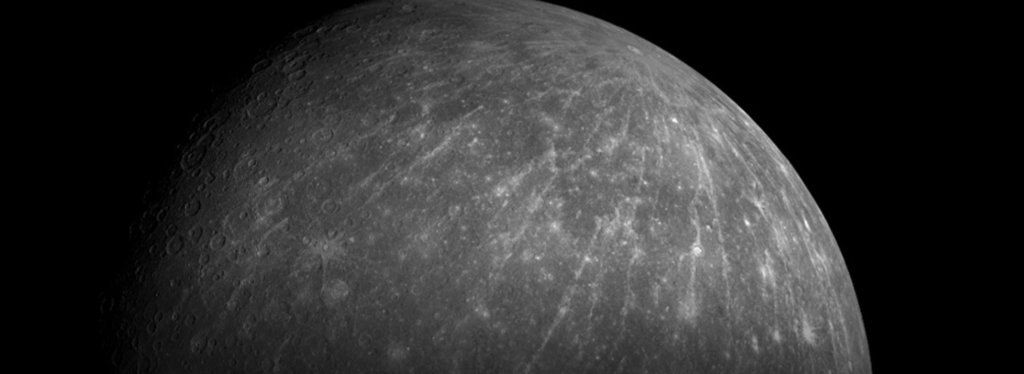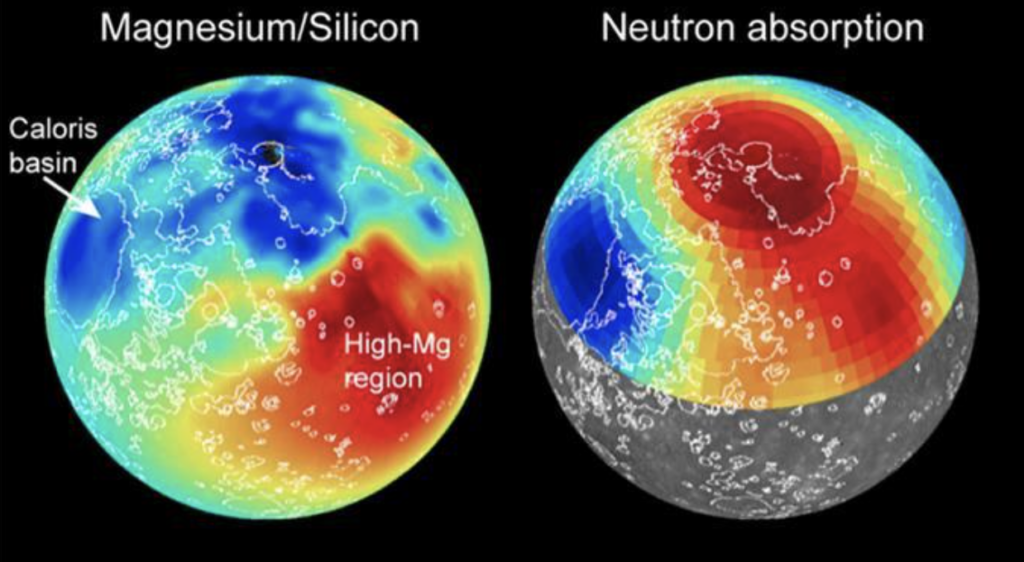What is Mercury Made Of?
Mercury looks something like our own Moon, and it is the solar system’s smallest planet. In addition, Mercury is the closest planet to the Sun, whose behavior significantly impacts it. So, what is Mercury made of?
Mercury is a terrestrial planet, and like its three nearest planetary neighbors, it has a core, mantle, and crust. However, the planet’s core is proportionally larger than its neighbors. And scientists think that’s because Mercury’s had a chaotic, frantic beginning.
Let’s start with the planet’s formation to see what Mercury is made of.

Table of Contents
Mercury’s Formation
About 4.5 billion years ago, gravity pulled together dust, silicate rocks, and swirling gas to create Mercury. It is primarily made of iron.
How Our Solar System Likely Formed
Scientists continue studying planets to understand their formation, but the core accretion model is the most widely accepted model for terrestrial planets like Mercury. Here’s a brief description of the events.
- The solar system was a solar nebula, basically a dust and gas cloud 4.6 billion years ago.
- Gravity caused a collapse of the material, which folded in upon itself and started spinning.
- The Sun formed in the nebula’s center.
- As the Sun formed, the rest of the materials began clumping up.
- Gravity pulls small particles together, forming them into larger chunks of particles.
- Solar winds blew away lighter elements, leaving the heavier rock materials to create the terrestrial worlds.
- Further from the Sun, solar winds impacted the lighter elements less. So they merged into the gas giants.
How Mercury Likely Formed
Mercury’s metallic core came together first. And then, it pulled lighter elements close to form the crust and mantle. Then, finally, it continued the collection process to gather an atmosphere. But because Mercury stayed small and close to the Sun, the powerful solar winds continuously stripped it of its atmospheric gasses.
Interestingly, Mercury’s atmosphere forms from gasses the solar winds bounce into it. And the same winds strip gasses to keep the atmosphere so thin.
What is Mercury Made Of?
Mercury is mainly made of iron and has a crater-filled pock-marked surface.
Mercury’s Surface
The planet’s surface looks similar to the Moon. The early solar system days proved violent, with many collisions, volcanic eruptions, and impacts. As a result, Mercury’s surface is full of craters.
For example, Mercury’s Caloris basin is a vast volcanic crater stretching almost 1,000 miles (1,600 kilometers) over the surface. A giant ring of mountains and volcanic vents surrounds it. NASA’s 2008 MESSENGER gave scientists the first views of the vast crater.
In addition, the orbiter discovered vast plains atop new craters that smoothed over older ones. These discoveries made scientists think the volcanos remained active even after the planet’s formation. However, no evidence exists to believe the volcanoes are currently active.
Messenger took about 100,000 images and used X-ray fluorescence spectra to learn more about what Mercury’s surface is made of. It found
- High magnesium-to-silicon ratios
- Low aluminum and calcium-to-silicon ratios
So, that meant the crust doesn’t have rich amounts of feldspar. So even though the small planet looks like the Moon, their compositions differ.
The spacecraft measurement data also show a sulfur-rich surface, about 20 times the amount in the Earth, Mars, and Moon surfaces. Additionally, low surface amounts of iron and titanium exist. So all these details make scientists think Mercury formed in a low-oxygen environment, which kept the planet’s size tiny.
What’s Inside Mercury’s Core?
Mercury is a very dense planet, second only to Earth’s density. Because of the calculated density, scientists determined Mercury is made of a metallic core.
Core Size
Here are the planet’s outer and core radii.
- Mercury’s radius = 1,516 miles (2,439.7 km)
- Mercury’s core radius = ~1,100 miles (~1,800 km)
So Mercury’s core is about 85 percent of the planet’s entire radius. And that’s a large core!
MESSENGER’S radar images discovered another incredible find. Mercury’s large core appears not solid after all, but it’s a molten liquid. And additionally, the planet’s core contains more iron than other planets.
And that likely is because, during formation, the Sun’s heat vaporized layers of the new surface. Another theory suggests that an impact tore away part of the outer shell during the young planet’s violent formation days. But either way, the core seems extra large since only a thin crust remains.
Core Composition
Mercury has a strange magnetic field (more about that below), suggesting that its center is liquid, while the core’s outskirts are solid. That runs opposite Earth’s core, whose center is solid with a liquid outer part.
Lighter elements inside Mercury’s core keep the iron from solidifying. But the whole core likely has a solid shell of sulfur and iron. So Mercury has a slim crust of about 300 to 400 miles (500-600 km) deep.
What is Mercury’s Atmosphere Made Of?
Mercury’s atmosphere is so thin that scientists say it is only an exosphere. As a result, atoms and molecules escape into space from the exosphere, which is usually the outermost layer in a planet’s atmosphere. For example, Earth’s exosphere is the layer where satellites orbit.
Mercury has such a small body that holding an atmosphere is nearly impossible. But add the planet’s close proximity to the Sun, and you’ll better understand why the atmosphere is hard to keep.
The Sun’s harsh solar winds barrage the small planet virtually non-stop. So it blasts up atoms from the planet’s surface and fills the atmosphere. But simultaneously, the solar winds sweep away what thin atmosphere Mercury managed to gather.
So, the solar winds add to and remove the planet’s helium and hydrogen-based atmosphere. In addition, MESSENGER measurement data shows the presence of silicon and potassium in the exosphere. These are surface materials whipped into the atmosphere by the powerful solar winds.

Mercury’s Temperature
Mercury is the nearest planet to the Sun but is not the hottest. Venus holds that trophy! However, Mercury still gets plenty toasty, especially on its dayside. NASA says the planet’s mean temperature is 333℉ (167℃.)
However, daytime temperatures skyrocket to 800℉ (426℃.) Now, that’ll get your fajitas sizzling! But on the flip side, Mercury’s nighttime temps plummet near the negative 330℉ (-201℃) mark.
Mercury’s thin exosphere means it has no thick cloud cover or insulating properties. And that creates hugely varying temperature ranges.
Mercury’s Magnetosphere
The region around a planet where its magnetic field dominates the solar wind’s influence is called its magnetosphere. For example, Mercury’s magnetic field generates from its iron core and interior electrical currents.
Although Mercury’s magnetosphere is much smaller and weaker than Earth’s, it is highly dynamic and active. It responds quickly to the solar wind changes that cause fluctuations and substorms within the magnetic field.
Summary: What is Mercury Made of?
Mercury is made of iron, primarily. Its molten core takes up 85% of the planet’s size. In addition, the planet’s proximity to the Sun keeps its helium and hydrogen atmosphere super thin. And that lack of insulation means the tiny world experiences extreme temperature variations.
